CHANGES August 22nd, 2024
SFAR 73 changed August 22nd 2024!
Learn about all the changes to SFAR 73 affecting Robinson R22 and R44 helicopters – enhanced autorotations, low-g flight training, blade stall and more. Also, goodbye to GELL, hello to GIML!….(Let me know your thoughts in the comments below). Make sure you are up to date on all the changes by reading this SFAR 73 Changes 2024 article or watch the video below.
This page will also be updated to reflect the changes.
- What is SFAR 73?
- What does SFAR 73 cover?
- SFAR 73 Ground Training (Awareness Training)
- SFAR 73 Aeronautical Experience
- SFAR 73 Pre-Solo
- SFAR 73 Pilot In Command (PIC) Flight Training
- SFAR 73 Flight Instructors
- SFAR 73 Flight Reviews
- SFAR 73 Passenger Carrying Currency
- More Info
- Feedback
- CHANGES August 22nd, 2024
What is SFAR 73?
SFAR 73 is a Special Federal Aviation Regulation, No. 73 (or SFAR 73 for short) that applies to anyone who wants to manipulate the flight controls, act as Pilot In Command (PIC), carry passengers, or teach in Robinson R22 and R44 helicopters (it does not apply to the R66). In short, it details required training and experience for those that want to fly and/or teach in R22 and R44 helicopters.
Why and how SFAR 73 came to be is best described by Tim Tucker (of Robinson Helicopters) in his own words – The Story Behind Special FAR 73.
The way SFAR 73 is organized and worded has been updated (August 2024), but it still can be tricky to navigate. So this post will try to fully break down and explain all the elements of SFAR 73 for R22 & R44 helicopters. It will cover the requirements for student pilots, qualified pilots new to the R22/R44, flight instructors, as well as R22/R44 passenger currency and flight review requirements.
What does SFAR 73 cover?
Use the links to jump to each section:
- Ground Training (previously known as Awareness Training) – required ground training for all those new to the R22 & R44 helicopters and required before anyone can touch the flight controls in flight.
- Aeronautical Experience – the required flight training and experience, broken down further by:
If you want to follow along in your own paper copy of the FAR/AIM, check out this short video on how to mark-up SFAR 73 [slightly out of date with the August 2024 update] for easy and quick reference:
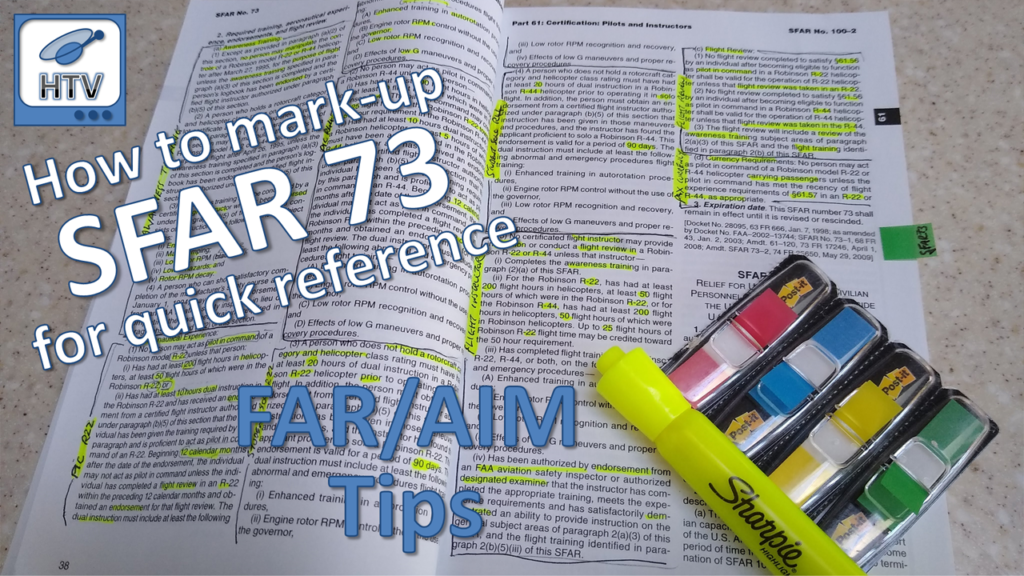
SFAR 73 Ground Training (Awareness Training)
SFAR 73 2.(a) Ground Training (previously known as Awareness Training) is the ground training portion of SFAR 73. Before manipulating the controls of an R22 or R44 helicopter a person must receive this ground training from a SFAR 73 ‘authorized’ flight instructor. The training received covers both R22 and R44 helicopters. According to SFAR 73 2.(a)(3) the ground training must include:
- Energy Management
- Rotor RPM Decay leading to Low RPM and Rotor Stall*
- Low G Hazards (& proper recovery) leading to Mast Bumping
Rotor Stall versus Blade Stall
This was a change in the August 2024 SFAR 73 update. It used to say “Blade Stall” which would more apply to a different aerodynamic hazard named ‘retreating blade stall‘ which happens at high speed. Rotor Stall on the other hand happens at any speed, and is very dangerous and unrecoverable situation with the rotor disk no longer generating lift. More information on the differences can be found in Robinson Safety Notice 24 (SN-24).
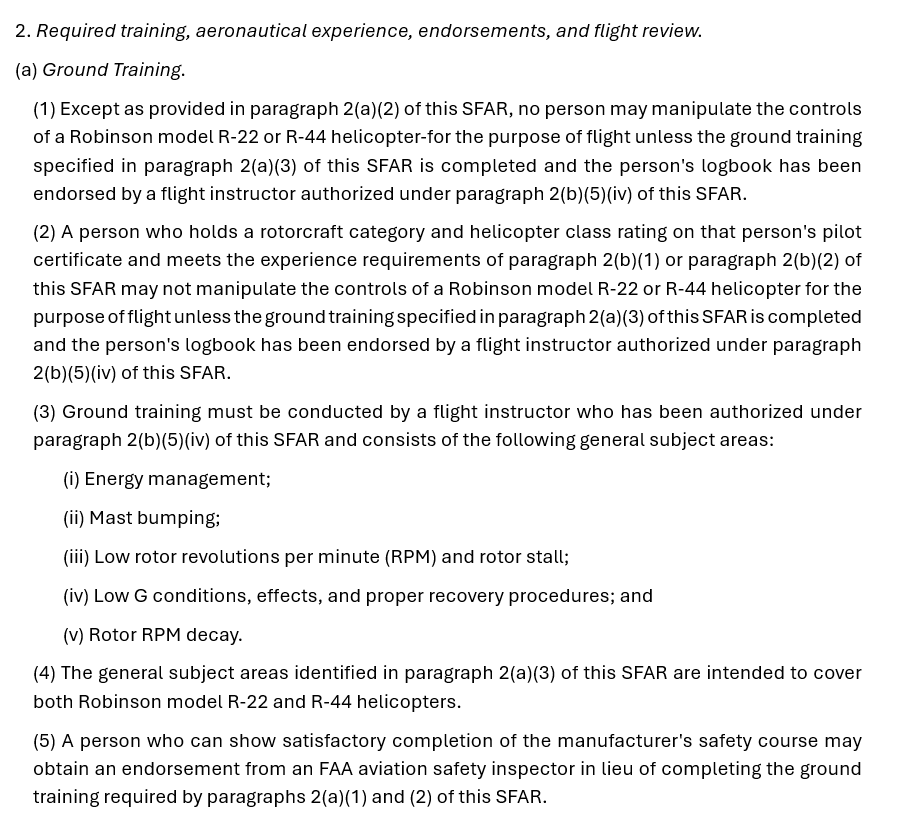
See the SFAR 73 Awareness Training Video explaining the concepts covered in SFAR 73 Ground Training (has not yet been updated for the August 2024 changes):
We also have an SFAR 73 Quiz (not yet updated for the August 2024 changes) to help test your knowledge of the subject areas required by SFAR 73 Ground Training:
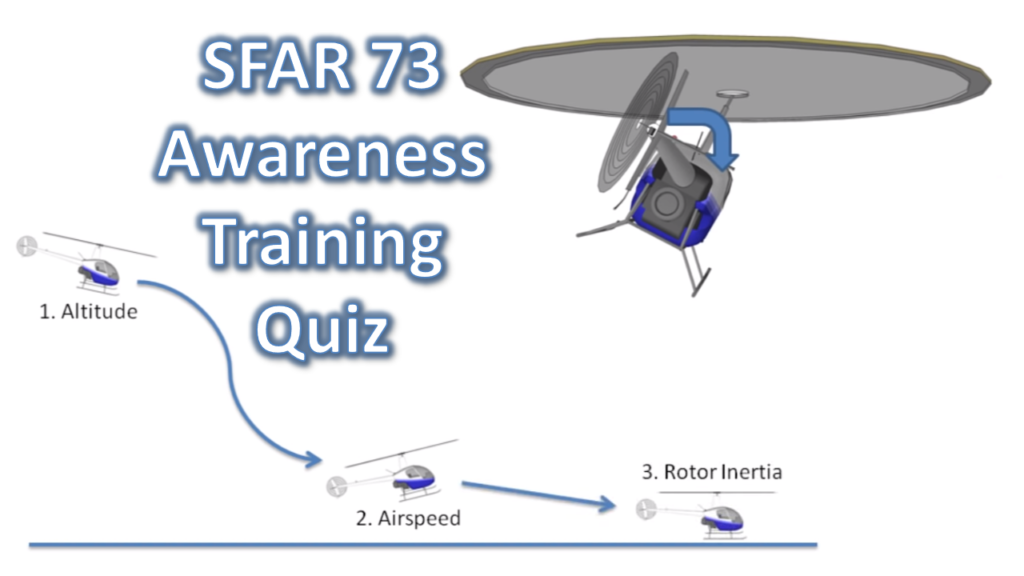
After completing the SFAR 73 Ground Training you should receive a SFAR 73 Ground Training Endorsement (see example below) – make sure you get that endorsement BEFORE you go fly! You could be unlucky enough to get ‘ramp checked’ by the FAA when you land…
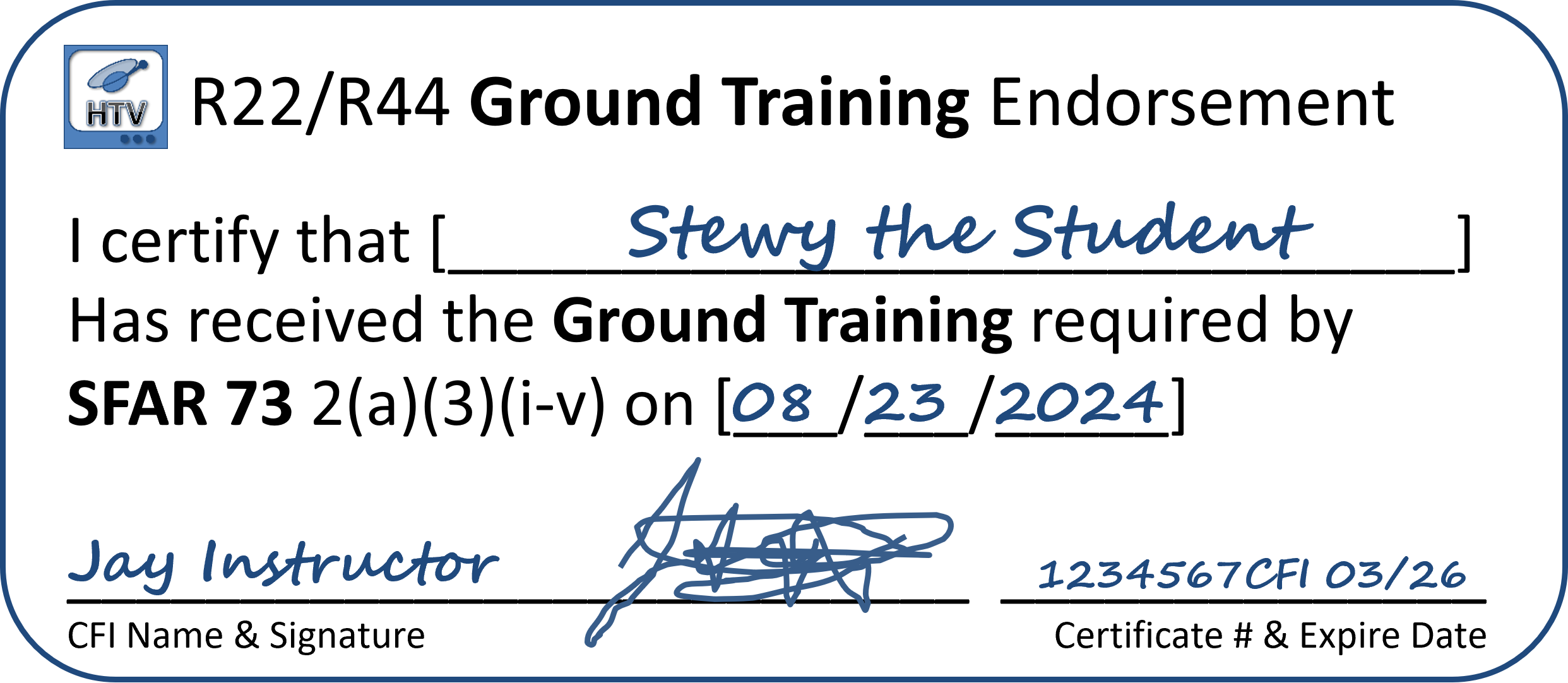
SFAR 73 Ground Training endorsement does not require an expiration date. Some instructors will add a short expiration date for this endorsement if giving a discovery or demo flight. It is good practice (and Robinson recommends) to always go over the Ground Training again prior to a student flying solo or getting an SFAR 73 PIC endorsement.
Also, technically you don’t need Ground Training if you attend the Robinson Safety Course and obtain an endorsement from an FAA aviation safety inspector.
SFAR 73 Aeronautical Experience
SFAR 73 2.(b) Aeronautical Experience covers the required experience and flight training (see Abnormal & Emergency Procedures below) and is further subdivided by:
- Pre-Solo
- Pilot in Command (PIC)
- Certified Flight Instructor (CFI)
- Flight Review
- Passenger Carrying Currency
Abnormal & Emergency Procedures Flight Training
Throughout SFAR 73, any time flight training is mentioned, the training must include at least the following abnormal and emergency procedures:
- (A) Training in autorotation procedures and energy management, including utilizing a combination of flight control inputs and maneuvering to prevent overshooting or undershooting the selected landing area from an entry altitude that permits safe recovery;
- (B) Autorotations at an entry altitude that permits safe maneuvering and recovery utilizing minimum rate of descent configuration [R44 only] and maximum glide configuration;
- (C) Engine rotor RPM control without the use of the governor; and
- (D) Low rotor RPM recognition and recovery.
GIML or GIM²L
A memory aid to cover the FSR 73 flight training is GIML or GIM²L for the R44:
G = Governor off RPM control
I = Inputs to avoid over/undershoot in an auto
M = Max glide [& Min rate in R44] autos
L = Low RPM recognition & recovery
Governor Off RPM Control & Low RPM Recognition & Recovery
You can combine governor off RPM control with low RPM recognition and recovery training. The low RPM recognition can start on the ground, with rotor RPM at flight speeds and then asking the student to close their eyes and listen as the instructor rolls the throttle down. On the ground is also a good place to start with a student experimenting with governor off throttle manipulation. Moving the training to flight, usually starts at cruise, turning the governor off, and then changing airspeed, altitude and add turns to demonstrate/learn how to control the RPM with the correlator and manual throttle manipulation. As part of that training, the RPM will come down to 97% or lower and activate the warning horn and light. The proper recovery technique will be used (simultaneously rolling on and slightly lowering the collective, maybe aft cyclic if speed allows, etc). The training would ideally then continue to a normally approach to hover, pedal turns and then set down or a go-around. There is no need to teach governor off pick up and takeoff as in a real governor failure, that situation would be prohibited per the POH limitations (and a bad idea! – See Robinson Safety Notice SN-36 Overspeeds During Liftoff).
We should also teach Low RPM recognition with the governor on (by overriding the governor), but IMO it is hard to effectively teach RPM recovery only with the governor on. This is because as the student will be trying to roll the throttle up (and the instructor is holding the throttle back to stop the governor doing the same thing). So you will have the governor and the student trying to roll the throttle up and the student isn’t getting the ‘actual’ feedback/feeling they would get from the throttle control if the instructor was not overriding the throttle. Also, if once the horn and light come on and the student starts to recover the instructor just lets go of the throttle, it is hard to know if the student is rolling up of just letting the governor recover the RPM.
Below are some videos of me teaching Governor Off operations and Low RPM Recognition and Recovery in forward flight and hover:
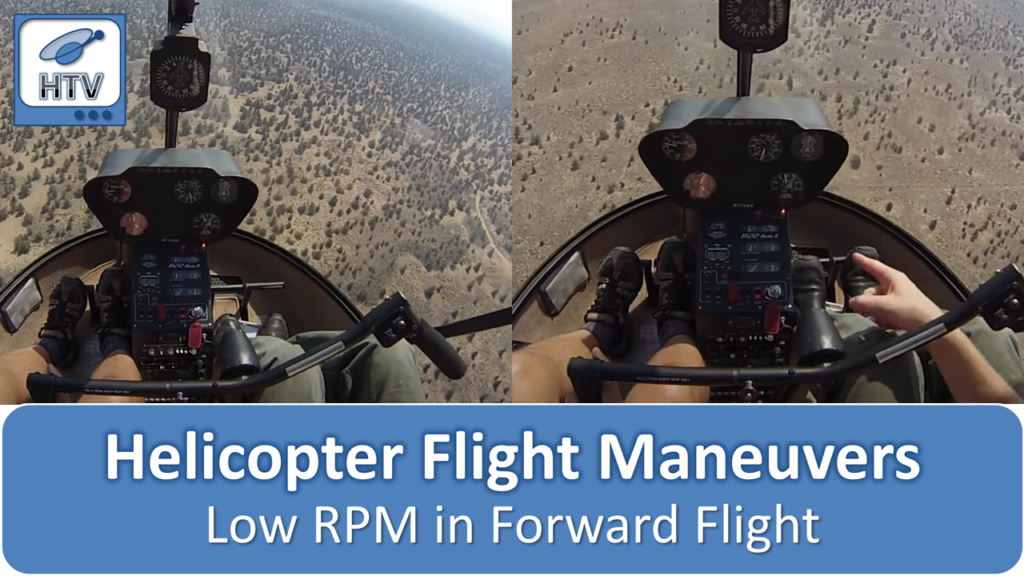
Low RPM in Forward Flight
This video demonstration instruction on Governor Off and Low RPM Recovery in Forward Flight.
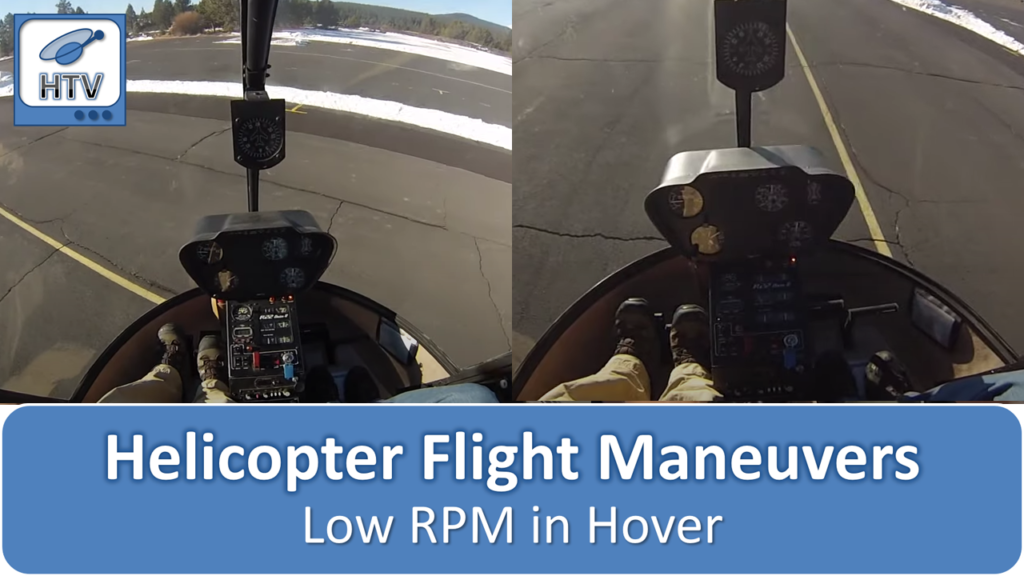
Low RPM in Hover
This video demonstration instruction on Governor Off and Low RPM Recovery in Hover.
Autorotation Training
SFAR 73 required training on autorotations using flight control inputs to prevent overshooting or undershooting and could include a variety of changes to flight path and/or rotor RPM to affect glide distance and path.
This SFAR 73 training in autorotation procedures’ comes up in the pre-solo, PIC, Flight Review and Flight Instructor sections of SFAR 73, so you can tailor the level of ‘inputs’ to the level of instruction being sought/given. Here are a list of some of the possible autorotations I use with students (with some video examples):
- Autorotation with basic turns or combined to ‘S-turns’
- Autorotation with 180 degree turn (when the spot is behind/along side you)
- Autorotation with change in airspeed & rotor RPM to change glide distance/duration
- Autorotation out of trim
- Zero speed autorotation entry (from an out of ground hover with the target below you) with the many variations
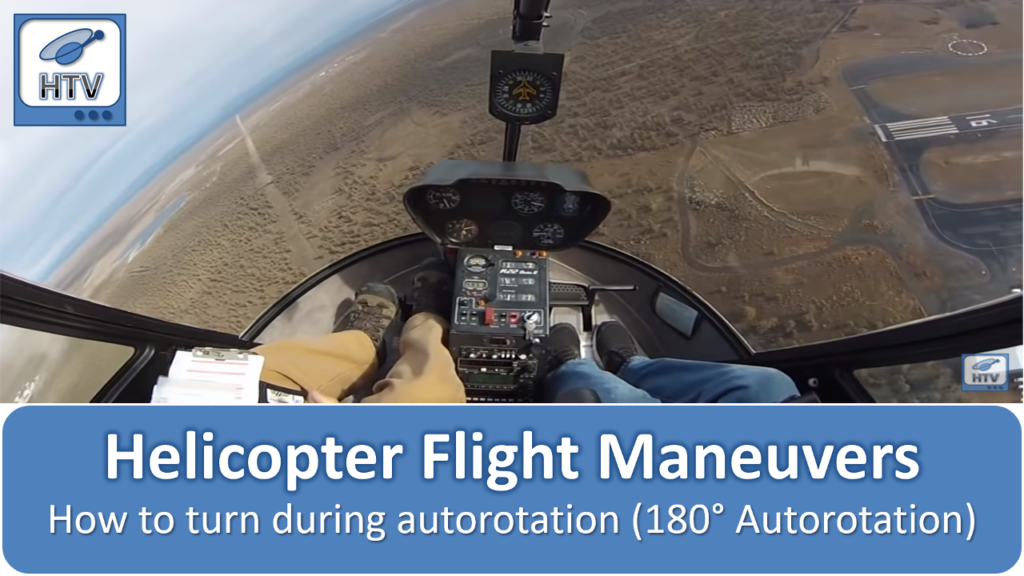
180 Degree Autorotation
Autorotation with 180 degree turn (when the spot is behind/along side you).
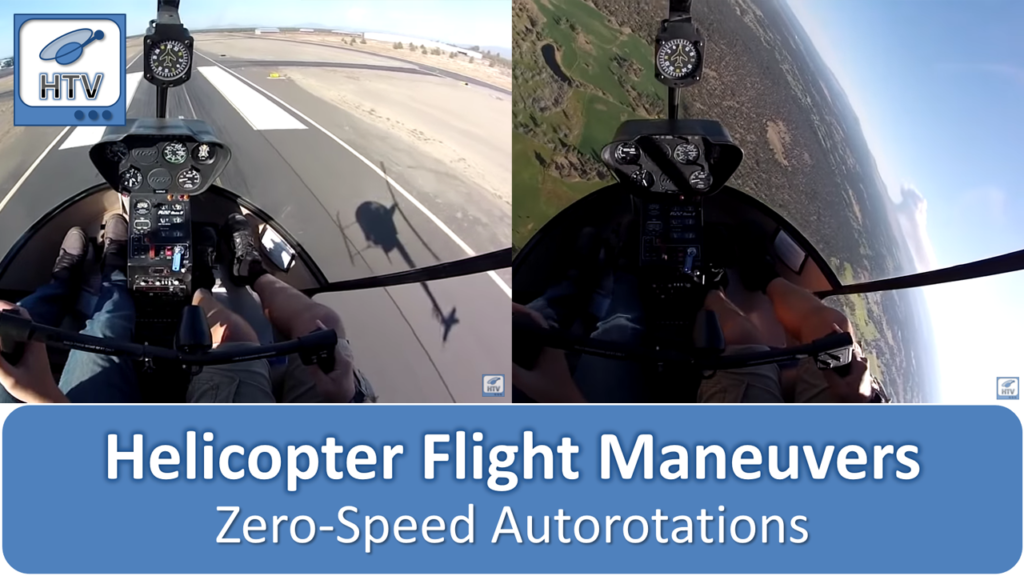
Zero Speed Autorotation
Entering an autorotation from an Out of Ground Effect Hover (usually maneuvering to a target spot directly underneath you).
But regardless of student level, all SFAR 73 flight training must also include autorotaions utilizing maximum glide configuration and if in an R44, also minimum rate of descent configuration. In reality most instructors will give minimum rate of descent training the R22 too. Learn why the SFAR 73 makes the distinction between the R22 and R44 here.
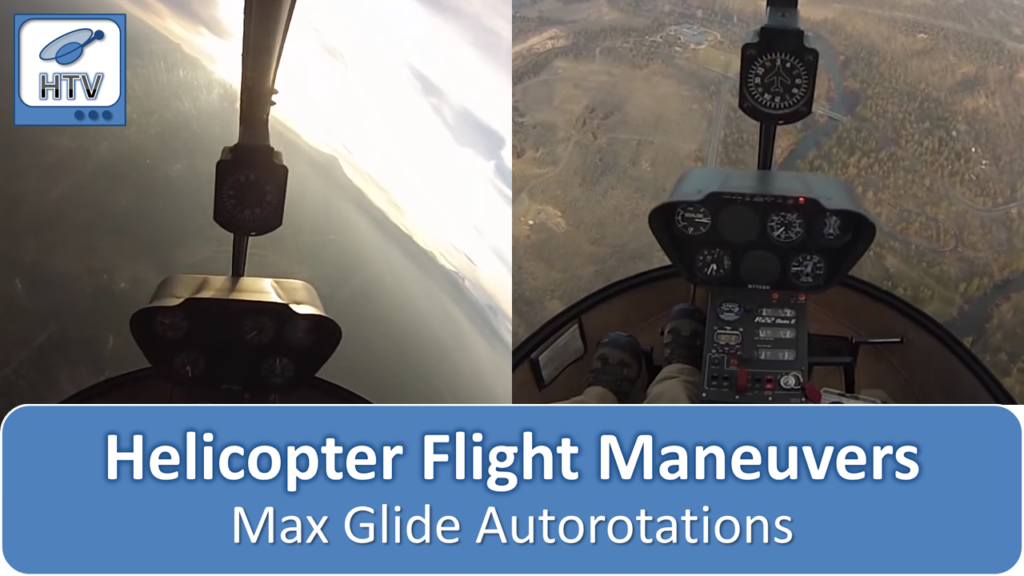
Max Glide Autorotation
Autorotations with reduced rotor RPM and increased airspeed for maximum glide.
Low-G Conditions, Effects, & Proper Recovery
Low-G can not be demonstrated (and should not be attempted) in flight and a recent SFAR 73 update has removed any mention of Low-G flight training. But I still recommend flight training on Low-G recovery from a theoretical Low-G scenario and a simulated right roll – working on muscle memory for recovery. This usually starts with an in-flight scenario of “imagine you are in turbulence and start feeling light in the seat…” and then a simulation of uncommanded right roll (instructor carefully nudges cyclic right) with the student expected to make an immediate, but gentle aft cyclic to reload the rotor disk before correcting the roll. See example of teaching Low G recovery here:
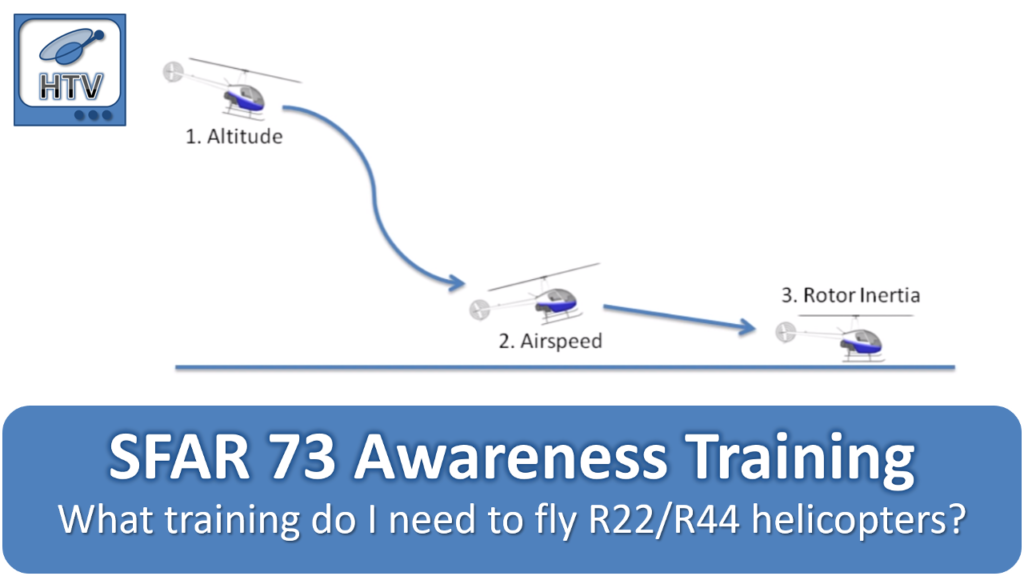
Low G Recovery in Flight
Low-G is NOT demonstrated in flight, but you can have a discussion and train for recovery from the right roll.
SFAR 73 Pre-Solo
SFAR 73 2(b)(3 and 4) requires that before going to solo (to fly a R22 or R44 helicopter on your own for the first time) a student pilot must:
- Receive the Ground Training (and the associated endorsement)
- Receive 20 hours of dual flight instruction in the model to solo (R22 or R44) from a SFAR 73 ‘authorized’ flight instructor
- That training must include the areas listed in SFAR 73 Abnormal & Emergency Procedures Flight Training
- Receive an SFAR 73 Solo endorsement (R22 or R44 specific) only valid for only 90 days
SFAR 73 Ground Training Review
As part of solo (and PIC) SFAR 73 training Robinson recommends a deeper review of the SFAR 73 Ground Training. The thinking is (and I agree) that the original Ground Training given prior to the first flight was probably a fully compliant and legal version of the required ground training, but was tailored to a brand new student pilot that is not familiar with the controls, systems or aerodynamics of a helicopter. I also think the student may have been distracted somewhat by the excitement and anticipation (and/or fear). It may have also been a month or two since the initial Ground Training was given and they may have forgotten some details. A review of the Ground Training also allows the student to come with any questions/clarifications that need to be addressed, now that they have a deeper and more applied understanding of the subjects covered.
After successfully completing the requirements of SFAR 73 2(b)(3 and 4) the student receives an 90 day endorsement like the one below:
SFAR 73 Pilot In Command (PIC) Flight Training
This part of SFAR 73 is mainly* aimed at already qualified helicopter pilots (Private Pilot, Commercial Pilot or Airline Transport Pilot) who are new to the R22 and R44. SFAR 73 2(b)(1 for R22 and 2 for R44) states that no person may act as Pilot in Command (PIC) of an Robinson R22 or R44 unless…And this is where it gets a little complicated and it is different for the R22 and R44 and how much prior experience the pilot has.
*It will also be required for a R22/R44 Student Pilot who becomes a rated Helicopter Pilot (passes their checkride) to be able to act as PIC in the R22/R44 as a Private Pilot during their checkride and after.
SFAR 73 PIC in R22
SFAR 73 2(b)(1) – to be qualified to act as PIC in an R22 you must have at least 200 hours (total time not PIC time) in helicopters and at least 50 of those hours must be in the R22.
OR, if you don’t have that experience, you must:
- Receive the Ground Training and endorsement
- Receive 10 hours of dual flight instruction in the R22 from a SFAR 73 ‘authorized’ flight instructor
- That training must include the areas listed in SFAR 73 Abnormal & Emergency Procedures Flight Training
- Receive an endorsement (R22 specific)
- Within 12 calendar months of the endorsement, you must completed a flight review in an R22 and obtained an endorsement for that flight review (covered later).
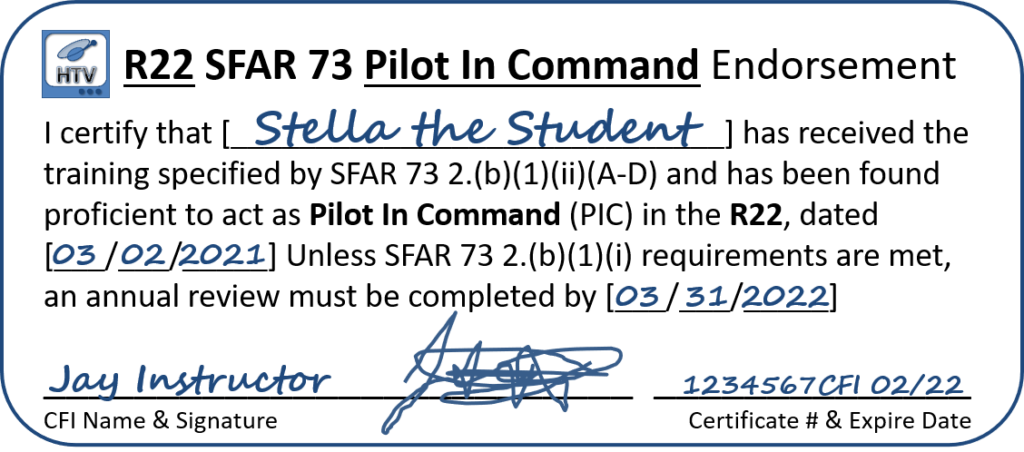
SFAR 73 PIC in R44
SFAR 73 2(b)(2) – to be qualified to act as PIC in an R44 you must have at least 200 hours (total time not PIC time) in helicopters and at least 50 of those hours must be in the R44. But here is a difference from the R22 PIC requirements – you can credit up to 25 R22 hours towards the 50 required for R44 PIC.
OR, if you don’t have that experience, you must:
- Receive the Ground Training and endorsement
- Receive 10 hours of dual flight instruction in ANY Robinson Helicopter (R22, R44 or R66!) of which 5 hours must be in an R44 – all from a SFAR 73 ‘authorized’ flight instructor
- That training must include the areas listed in SFAR 73 Abnormal & Emergency Procedures Flight Training
- Receive an endorsement (R44 specific)
- Within 12 calendar months of the endorsement, you must completed a flight review in an R44 and an endorsement for that flight review (covered later).
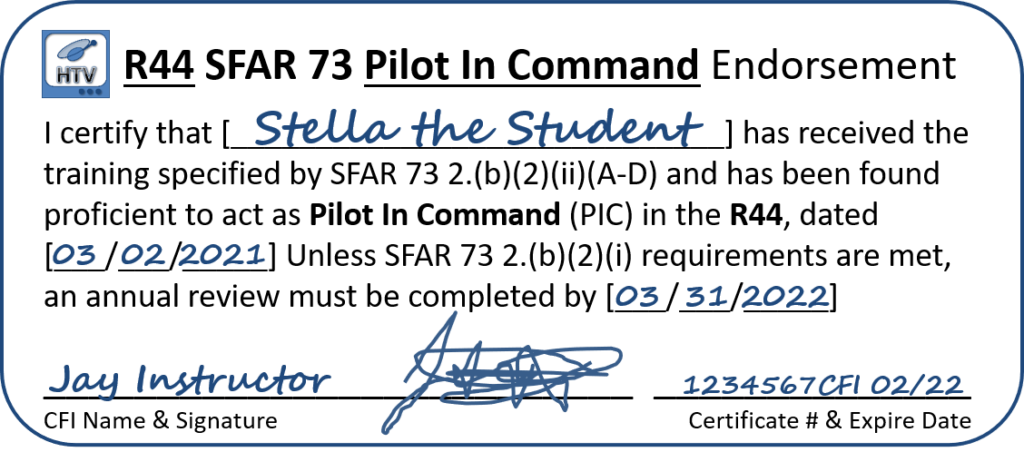
SFAR 73 Flight Instructors
SFAR 73 2(b)(5) To be authorized to instruct or provide a flight review in an R22 or R44 helicopter (and to give SFAR 73 Ground Training) you need some experience (see below) and a ‘checkride’ with a Designated Pilot Examiner (DPE) or the FAA, to demonstrate you can teach the required SFAR 73 Ground Training on the ground and then the Aeronautical Experience in flight before they give you a SFAR 73 Instructor Endorsement.
To give flight instruction or provide a flight review in an R22 helicopter you need:
- SFAR 73 Ground Training & endorsement
- 200 hours helicopter
- 50 hours in the R22
- Endorsement from DPE or FAA to teach in R22
To give flight instruction or provide a flight review in an R44 helicopter you need:
- SFAR 73 Ground Training & endorsement
- 200 hours helicopter
- 50 hours in the R44 (up to 25 hours can be credited from R22 time)
- Endorsement from DPE or FAA to teach in R44
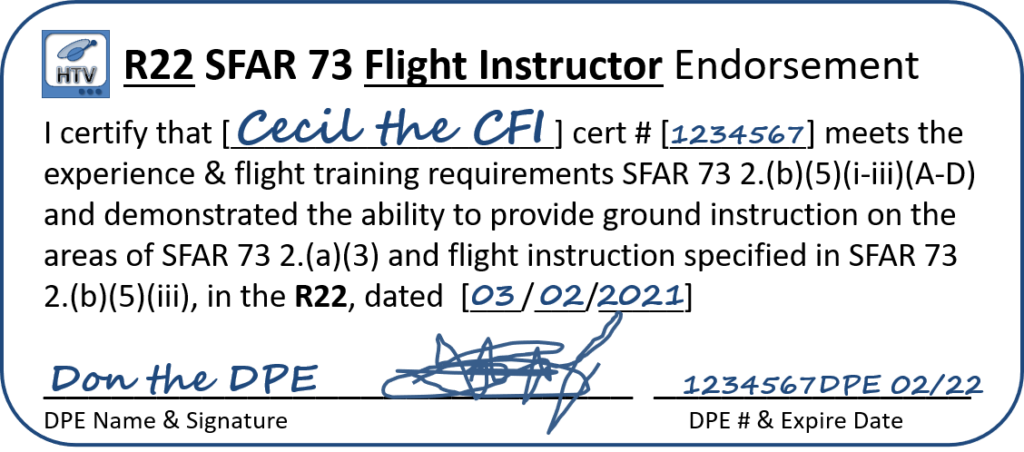
SFAR 73 Flight Reviews
This can be a bit confusing because under SFAR 73 there are two different types of Flight Review. The first is an ‘Annual SFAR 73 PIC Flight Review’ required within 12 calendar months of an R22 or R44 SFAR 73 PIC endorsement, if you have less than 200 hours (total time not PIC time) in helicopters and at least 50 of those hours must be in the R22/R44 (depending on which PIC endorsement you have). So if you meet those hour minimums, you will not need to do an annual SFRA 73 PIC Flight Review.
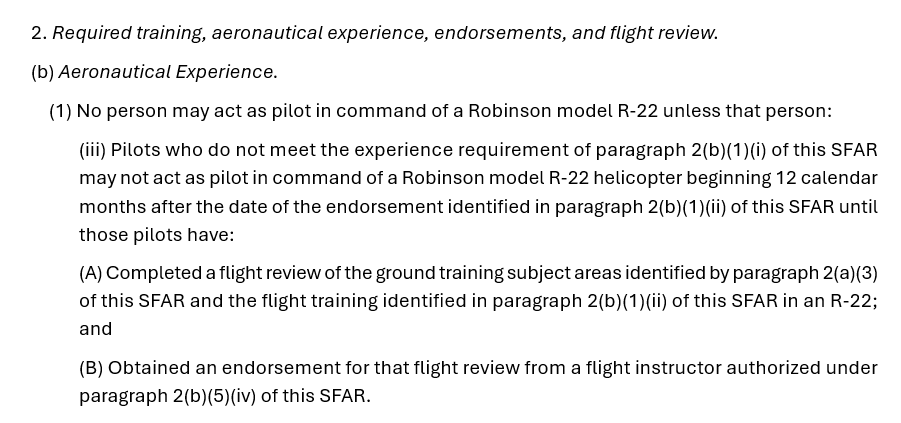
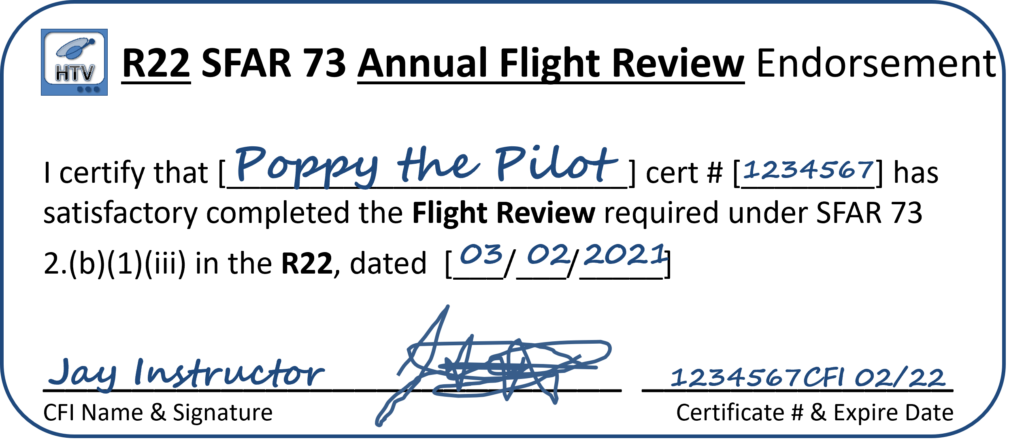
The second type of review is the type of Flight Review all pilots have to complete every two years (used to be called a Biannual Flight Review or BFR) and that is conducted under (§ 61.56). But under SFAR 73 2(c) – a Flight Review (to meet § 61.56) is not valid for an R22 helicopter unless that flight review was taken in an R22 and the same for an R44. So if you want to legal in both the R22 and the R44 you will need two separate flight reviews, one in each aircraft.
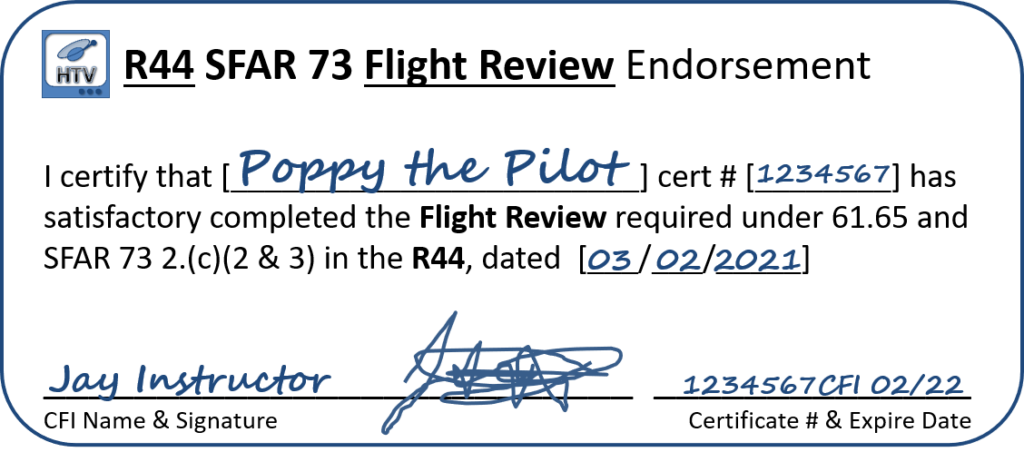
SFAR 73 Passenger Carrying Currency
SFAR 73 2(d) – For Passenger Carrying Currency (§ 61.57) day or night, the recent experience requirement is type specific for the R22 & R44.
So for example, to carry passengers during the day in an R22, you must complete (& log) 3 takeoff and 3 landings in the past 90 days in an R22.
And to carry passengers during the day in an R44, those landings in an R22 don’t count for the R44, you must complete (& logged) 3 takeoff and 3 landings in the past 90 days in an R44.
DISCLAIMER – make sure you are fully informed on the latest regulations and their application.
For official guidance on laws and regulations, refer to your Certified Flight Instructor (CFI) or local Flight Standards District Office (FSDO) . Helicopter Training Videos aims to promote aviation knowledge and safety but makes no guarantees regarding accuracy or legal applications.
More Info

SFAR73 Awareness Training Video
This video demonstration instruction on Governor Off and Low RPM Recovery in Hover . This video will be updated for the 2024 SFAR 73 changes.

SFAR73 Awareness Training Quiz
Take this quiz to see how much you know about SFAR 73 Awareness Training. This video will be updated for the 2024 SFAR 73 changes.

SFAR73 Mark-Up
This video shows how to mark-up SFAR 73 in the FAR/AIM for quick reference. This video will be updated for the 2024 SFAR 73 changes.
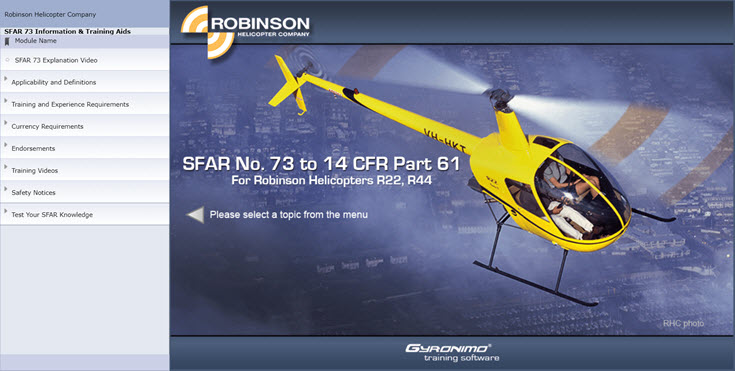
Robinson SFAR 73 Website
Robinson have a great website all about SFAR 73 with detailed presentation videos from Tim Tucker and Frank Robinson himself
- Make sure you have the latest R22 POH or R44 POH and reviewed Robinson’s Safety Notices
- Also if you need a FAR/AIM or any other helicopter-related books? Check out our Recommended Book List and help support Helicopter Training Videos at no extra cost to you (Amazon Affiliate links).
Feedback
How was your SFAR 73 Ground and Flight Training? How do you understand and keep track of SFAR 73? Or maybe you instruct – tell us how you teach it. Use the comments form below, and thanks for your feedback.



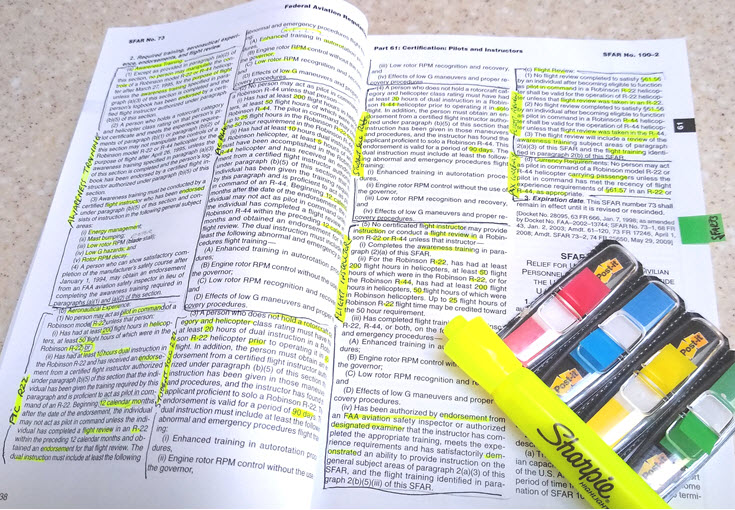
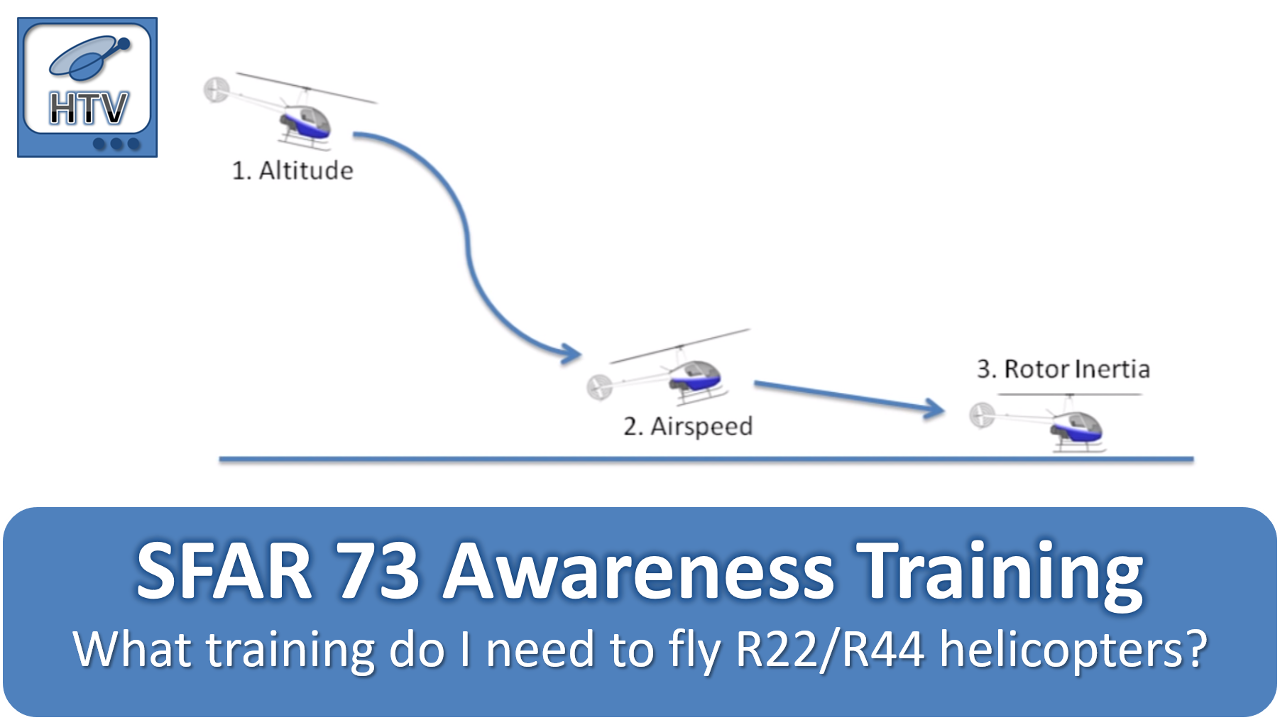
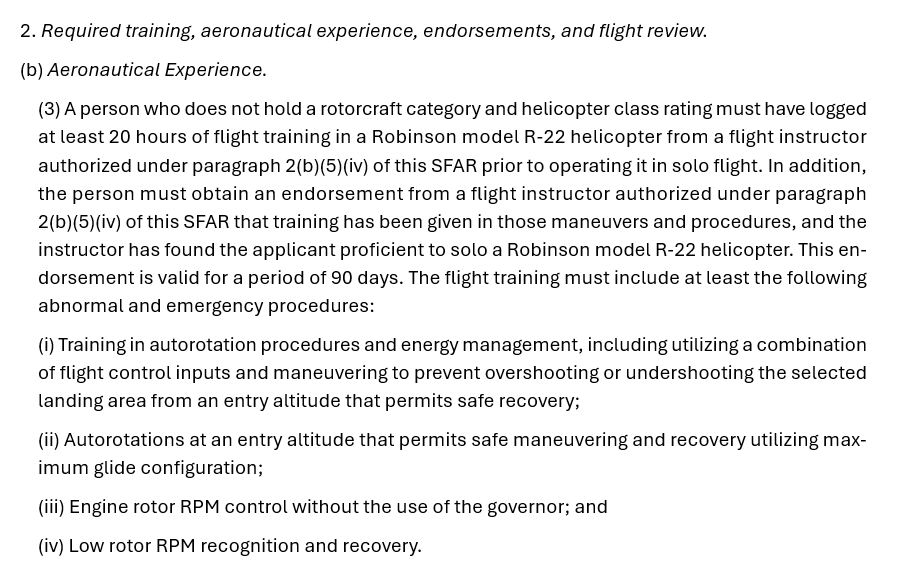
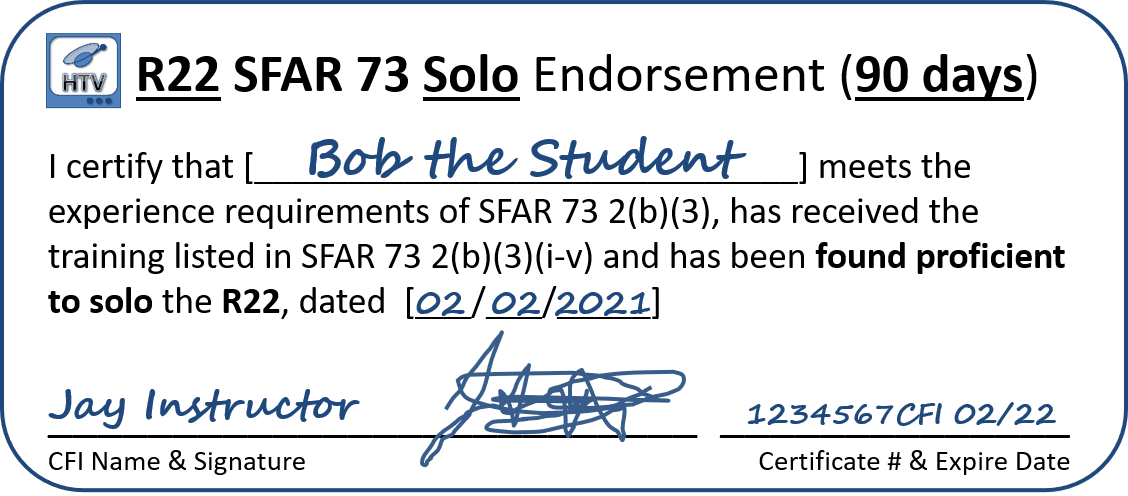
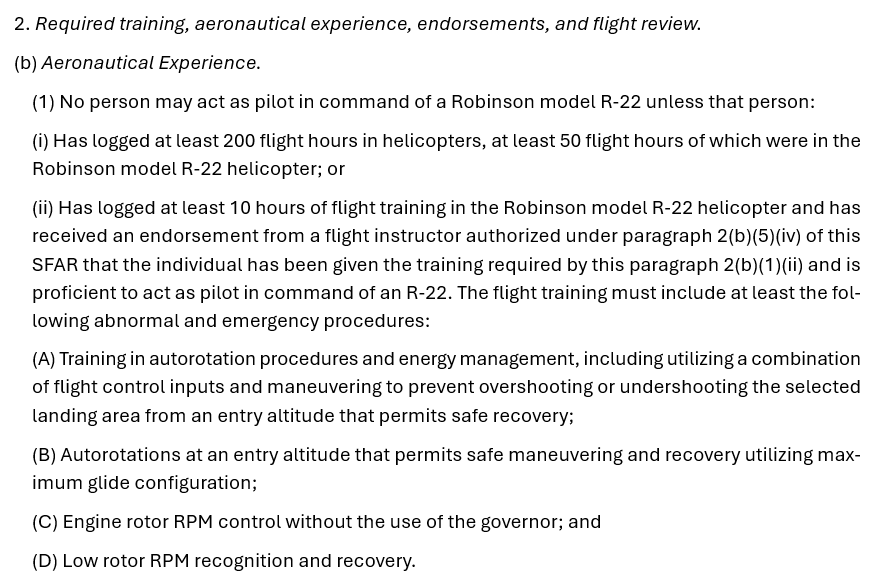
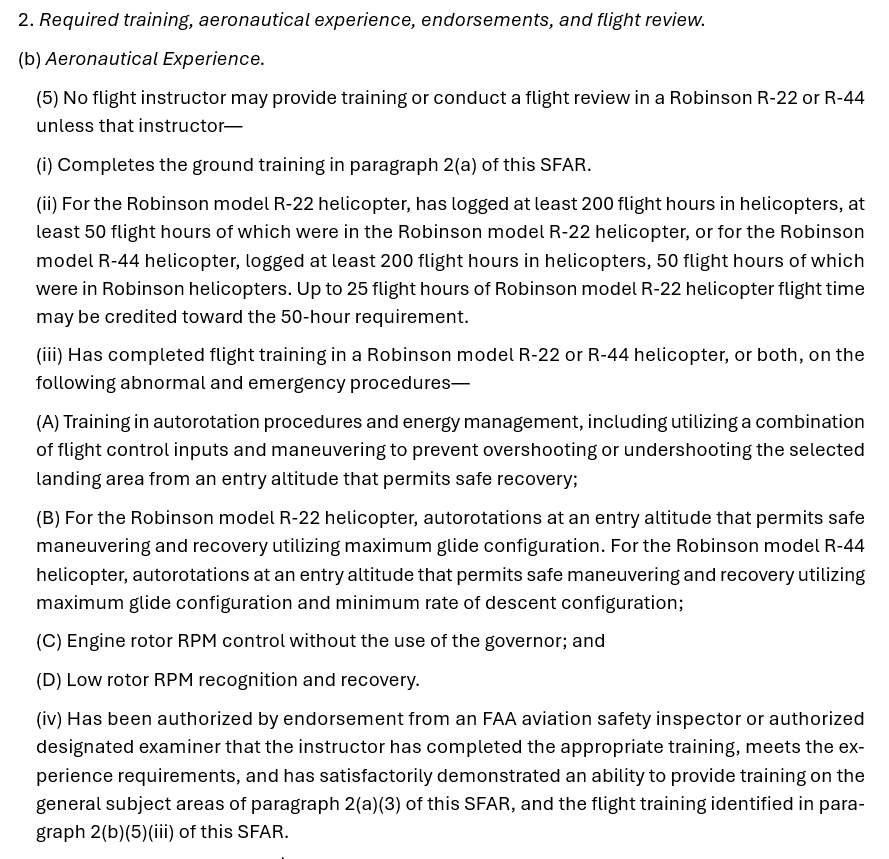
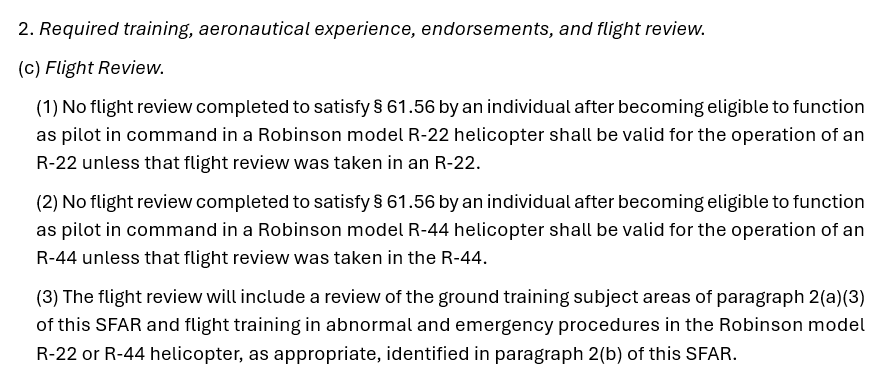

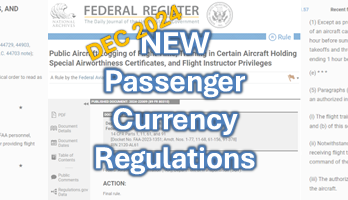
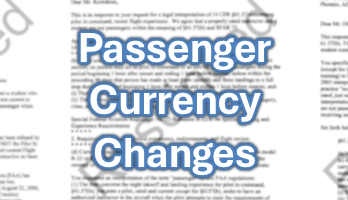
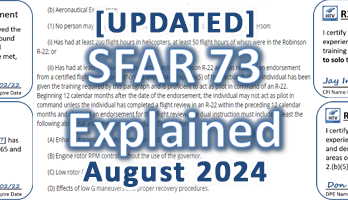
Hi sir . Thanks . I want to know how many hours I have to learn in order to be an instructor on R44 , knowledge that I have 2912 flight hours, CPL on AW139 and I am an ex military instructor pilot on helicopter? Thank you so much.
I am waiting for your answer
Mustapha,
Good question! It depends what country you want to instruct in. I only know of the requirements in the United States. In the US you will need 200 hours helicopter (which you have) and then 50 hours in the R44 (and you can credit up to 25 of those hours in an R22). There is a bit more to it, you can find all the details here: https://www.helicoptertrainingvideos.com/2021/03/sfar-73-for-r22-r44-helicopters-explained/#Flight-Instructor
So to be qualified as PIC in the R22, I either need 10 hours of dual, or i have 200 hours total helicopter time and 50 hrs in the R22.
So how do I have 50 hrs in the R22 in the first place, if until I have 50 hrs in the R22 I am not qualified to be PIC in the R22.
That makes no sense at all.
You have 50 hrs in the R22 but NOT dual instruction. Unlikely you would get 50hrs on the controls but not at least 10 hrs official instruction from an SFAR 73 R22 authorized CFI.